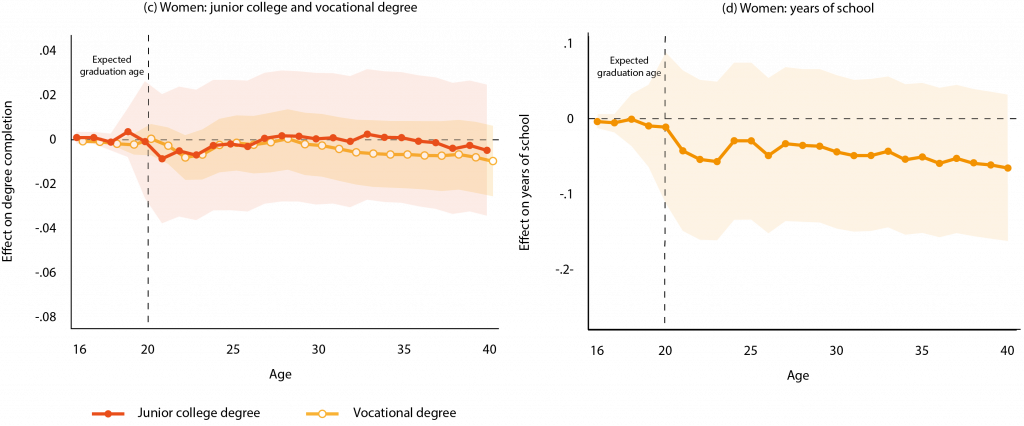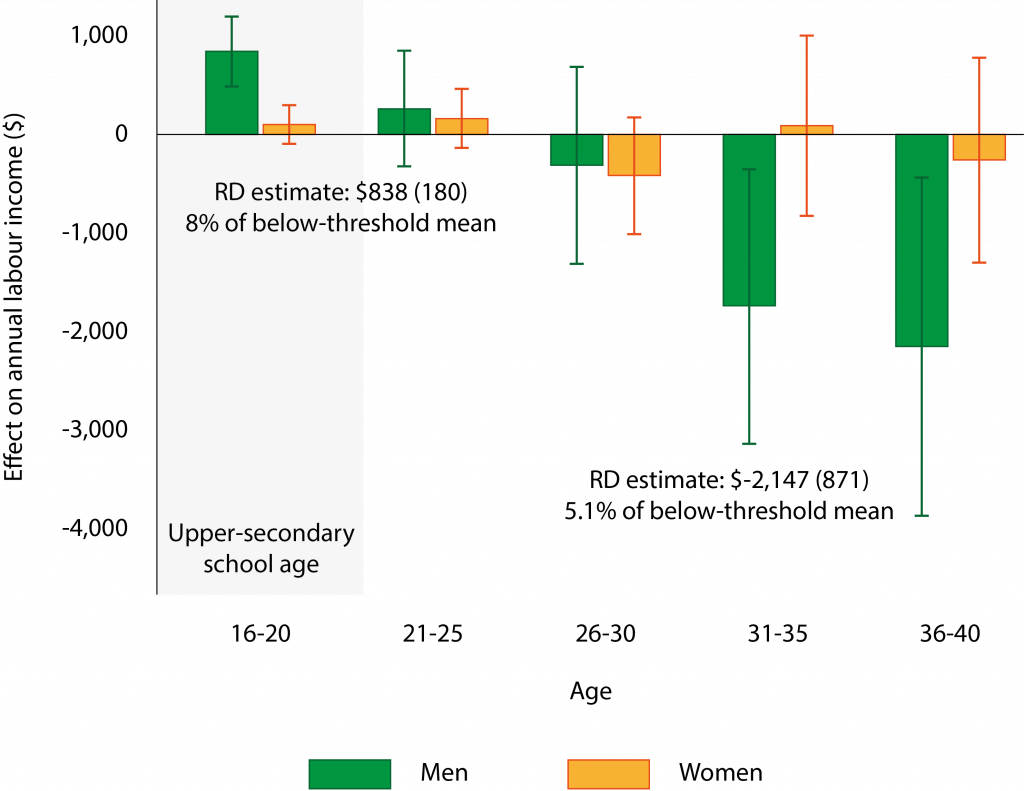Educational scarring
Jósef Sigurdsson is an Assistant Professor at Stockholm University
Business cycles are costly. Recessions damage the economy, destroy jobs, and lead to persistent losses in earnings. An extensive macroeconomic literature has quantified the welfare costs of recessions, emphasising their impact on the level and volatility of household consumption (eg. Lucas 1987, 2003, Krebs 2007, Krusell et al 2009).
However, economic booms may also have costs. Temporary wage increases raise the opportunity cost of schooling, potentially reducing school enrolment and increasing dropout rates (Mincer 1958, Becker 1962). Through this channel, booms may permanently reduce human capital.
Research has documented reduced school enrolment and increased dropout rates during periods of hot labour markets (eg. Cameron and Taber 2004), housing booms (Charles et al 2018), natural resource booms (Black et al 2005, Cascio and Narayan 2020), and following factory openings (Atkin 2016).
Ultimately, the macroeconomic consequences depend on how economic booms affect human capital and productivity in the long run. In a recent paper (Sigurdsson 2024), I provide novel insights into this phenomenon, exploiting a tax reform in Iceland to study this effect.
In the late 1980s, Iceland transitioned to a pay-as-you-earn tax system from one where current-year taxes were based on the previous year’s income (Bianchi et al 2001, Sigurdsson 2023). During the transition year of 1987, no taxes were collected on income earned that year. This created an ideal natural experiment: a one-year wage increase with no effects on lifetime returns to education.
Educational scarring of men
To estimate the effect of the tax-free year on school dropout rates and educational attainment, I compare teenagers around the compulsory schooling age. Specifically, I compare those who had turned 16 and completed compulsory schooling, making them eligible to leave school during the tax-free year, to younger students who were still required to stay in school.
Figure 1 presents the estimated effect on educational attainment, measured by both degree completion and completed years of schooling, for men and women separately. The data reveal a significant difference in men’s degree completion emerging at the expected graduation age of 20, consistent with men dropping out of school during the tax-free year.
I estimate a 5 percentage point, or 8%, decrease in the completion of post-compulsory education. This effect is driven by increased dropout rates from four-year academic tracks, typically attended between the ages of 16 and 20, which are the qualifications for university enrolment.
The evidence suggests that education policies can complement macroeconomic policies in mitigating the cost of business cycles
In principle, when faced with a temporary increase in the opportunity cost of schooling, students might choose to temporarily substitute schooling with work, planning to return and complete their education after the tax-free year.
However, Figure 1 demonstrates that this was not the case. Young men who left school during the tax-free year did not return later to complete their education, resulting in a permanent education loss.
Figure 1. Effect of tax-free year on school dropout and educational attainment


Source: Sigurdsson (2024)
Interestingly, unlike men, women did not show a similar dropout pattern, despite being equally affected by the zero-tax policy and constituting a larger share of junior college students at the time.
Loss in lifetime earnings
Dropping out of school led to significant losses in lifetime earnings. Figure 2 shows that while dropouts initially earned higher incomes, their earnings gradually lagged behind those of their peers in adulthood. At prime working age, the tax-free year reduced earnings for affected men by approximately $2,100, or 5.1%.
When translated into a causal effect of dropout on earnings, using the estimated effect on dropout discussed above, the estimate suggests that if those who dropped out had completed their education, they would have doubled their annual prime-age earnings.
Figure 2. Effects of Tax-free year on labour earnings in the short and long run

Source: Sigurdsson (2024)
The cost of business cycles
The evidence suggests that business cycles may be costlier than previously thought. Traditional estimates focus on variations in income and consumption during recessions, with potential long-run effects (Shen and Malmendier 2021). However, these estimates overlook the effects that booms may have on educational attainment.
The results presented my paper allow for the quantification of this channel using an estimate of the elasticity of years of schooling to a transitory change in the opportunity cost of school attendance. The elasticity estimate suggests that a transitory boom raising teenage wages by 10% leads to a 1.5% permanent loss in years of schooling for the affected cohorts.
This reduction in schooling is likely to have significant negative consequences for long-term productivity and output. Back-of-the-envelope calculations for Iceland suggest that the human capital loss in the 1987 tax-free year resulted in a 0.1-0.2% reduction in aggregate output in 2020.
While recessions may counteract the loss in human capital by lowering opportunity costs and leading students to stay longer in school, they may also negatively affect educational attainment through binding borrowing constraints and reduced resources.
While both forces may be at play, existing research has found recent recessions to reduce rather than increase educational attainment (eg. Hilger 2016, Stuart 2022).
Implications for policy
What does this imply for policy? The evidence suggests that education policies can complement macroeconomic policies in mitigating the cost of business cycles. One promising policy candidate is raising the compulsory schooling age. Existing evidence indicates that this approach can effectively increase educational attainment and retain students in school beyond the compulsory age (Oreopoulos 2007).
I estimate that if Iceland’s compulsory schooling age had been 17 instead of 16 during the tax-free year, the loss in educational attainment could have been reduced by approximately 40%.
Alternatively, policymakers could consider procyclical education policies aimed at keeping students in school when opportunity costs are high. For example, increasing education subsidies or lowering interest rates on student loans could counteract the higher opportunity costs and the incentives to leave school.
References
Atkin, D (2016), “Endogenous skill acquisition and export manufacturing in Mexico,” American Economic Review 106: 2046–85.
Becker, GS (1962), “Investment in human capital: A theoretical analysis,” Journal of Political Economy 70: 9–49.
Bianchi, M, BR Gudmundsson, and G Zoega (2001), “Iceland’s natural experiment in supply-side economics,” American Economic Review 91: 1564–1579.
Black, DA, TG McKinnish, and SG Sanders (2003), “Does the availability of high-wage jobs for low-skilled men affect welfare expenditures? Evidence from shocks to the steel and coal industries,” Journal of Public Economics 87: 1921–1942.
Cameron, SV and C Taber (2004), “Estimation of educational borrowing constraints using returns to schooling,” Journal of Political Economy 112: 132–182.
Cascio, EU and A Narayan (2020), “Who Needs a Fracking Education? The Educational Response to Low-Skill-Biased Technological Change,” ILR Review, 1–34.
Charles, KK, E Hurst, and MJ Notowidigdo (2018), “Housing Booms and Busts, Labor Market Opportunities, and College Attendance,” American Economic Review 108: 2947–94.
Hilger, NG (2016), “Parental job loss and children’s long-term outcomes: Evidence from 7 million fathers’ layoffs,” American Economic Journal: Applied Economics 8: 247–283.
Krebs, T (2007), “Job displacement risk and the cost of business cycles,” American Economic Review 97: 664–686.
Krusell, P, T Mukoyama, A Sahin, and AA Smith Jr (2009). “Revisiting the welfare effects of eliminating business cycles,” Review of Economic Dynamics 12: 393–404.
Lucas, RE (1987), Models of business cycles, Vol. 26, Basil Blackwell.
Lucas, RE (2003), “Macroeconomic priorities,” American Economic Review 93: 1–14.
Oreopoulos, P (2007) “Would more compulsory schooling help disadvantaged youth? Evidence from recent changes to school-leaving laws,” in The problems of disadvantaged youth: An economic perspective, University of Chicago Press, pp. 85–112.
Sheng Shen, L and UM Malmendier (2021), “Scarred consumption”, VoxEU.org, 15 March.
Sigurdsson, J (2023), “Labor Supply Responses and Adjustment Frictions: A Tax-Free Year in Iceland,” working paper, Stockholm University.
Sigurdsson, J (2024), “Transitory Earnings Opportunities and Educational Scarring of Men”, CEPR Discussion Paper No. 19066.
Stuart, BA (2022), “The long-run effects of recessions on education and income,” American Economic Journal: Applied Economics 14: 42–74.
This article was originally published on VoxEU.org.




